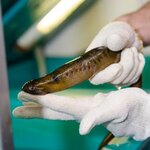Evolution

The idea of evolutionary imbalance when it comes to invasive species is not new, Charles Darwin articulated it.
The concept is that species from regions with deep and diverse evolutionary histories are more likely to become successful invaders in regions with less deep, less diverse evolutionary histories. Darwin's original insight was that the more challenges a region's species have faced in their evolution, the more robust they'll be in new environments.
To predict the probability of invasiveness, ecologists
Dov Sax of Brown University and Jason Fridley of Syracuse University…

Seedless watermelon, salmon, and strawberries all have one thing in common - unlike most eukaryotic multicellular organisms that have two sets of chromosomes, these organisms are all polyploid, meaning they have three or more sets of chromosomes. Seedless watermelon and salmon have 3 and 4 sets of chromosomes, respectively, while strawberries have 10.
Most plant species are polyploid. Polyploidy, or genome doubling, was first discovered over a century ago, but only recently, with the development of molecular tools, has it been revealed just how ubiquitous it is. Polyploidy is being…

In a region where modern humans are believed to have originated roughly 200,000 years ago,
DNA from the skeleton of a man who lived 2,330 years ago has a DNA profile that places it among the 'earliest diverged' – oldest in genetic terms – found to-date.
Somehow the group broke off early in human evolution and became geographically isolated so the skeleton is modern, but its DNA is old.
Mitochondrial DNA provided the first evidence that we all come from Africa, and helps us map a figurative genetic tree, all branches deriving from a common 'Mitochondrial Eve'.…

Astronomers have discovered an unusual carbon-based molecule – one with a branched structure – contained within a giant gas cloud in interstellar space - 27,000 light years away. Like finding a molecular needle in a cosmic haystack, astronomers have detected radio waves emitted by isopropyl cyanide. The discovery suggests that the complex molecules needed for life may have their origins in interstellar space.
Using the Atacama Large Millimeter/submillimeter Array (ALMA), researchers studied the gaseous star-forming region Sagittarius B2.
Organic molecules usually found in these star-…

A key indicator of how successfully one species of monkey will breed can be determined by skin color, a new study has shown. Skin coloration in male and female rhesus macaques is an inherited quality – the first example of heritability for a sexually-selected trait to be described in any mammal.
The team collected more than 250 facial images of free-ranging rhesus macaques, which are native to South, Central and Southeast Asia and which display red skin coloring around the face, as well as the genital and hind-quarter areas.
Using these images and 20 years of genetic parentage data, the…

So much for patriarchy. When it comes to evolution, female populations have always been larger than male populations throughout human history, according to a new study in Investigative Genetics which used paternal genetic information to analyse the demographic history of males and females in worldwide populations.
The study compared the paternally-inherited Y chromosome (NRY) with maternally inherited mitochondrial DNA (mtDNA) of 623 males from 51 populations. The analysis showed that female populations were larger before the out-of-Africa migration and remained so throughout almost all…

A new study uses tree rings to document arroyo evolution along the lower Rio Puerco and Chaco Wash in northern New Mexico.
Arroyos are deep, oversized channels that have vertical or steeply cut walls made up of silt, clay, or sand. Because of this makeup, arroyo systems are inherently unstable, shifting at the century to millennial scale between broad floodplains and incised, high-walled channels, in which floods have a high stream power that causes more rapid erosion.
By determining burial dates in tree rings from salt cedar and willow, investigators were able to precisely date arroyo…

Parasitic lamprey are a challenge to study but an important one - they are an invasive pest in the Great Lakes but difficult to study under controlled conditions because they live up to 10 years and only spawn for a few short weeks in the summer before they die.
Lamprey are slimy, eel-like parasitic fish with tooth-riddled, jawless, sucking mouths, and rather disgusting to look at, but thanks to their important position on the vertebrate family tree, they can offer important insights about the evolutionary history of brain development, according to a new paper in Nature.
"Lamprey are…

Can the brown anole lizard outrun climate change? Credit: Ianaré Sévi, CC BY
By Amanda Bates, University of Southampton
Lizards from the deserts of Australia to the tops of mountains in Costa Rica have given us insights into how animals take advantage of their environment to be less cold-blooded. Lizards seek out sunny patches or the warm underside of rocks where they can soak up the heat to enhance digestion or run faster. When it gets too hot, they can escape the heat by finding shade or retreating to burrows underground.
In particular, tropical species, including lizards, are thought to be…

"Ontogeny recapitulates phylogeny" biologists once said - meaning that an animal's "ontogeny", its embryonic development, replays its entire evolutionary history.
Today our understanding a more nuanced and a better way to figure out how animals evolved is to compare regulatory networks that control gene expression patterns, particularly embryonic ones, across species. But that task can be humbling, according to Stowers Institute for Medical Research Scientific Director Robb Krumlauf, Ph.D. and colleagues, who show that the sea lamprey Petromyzon marinus, a survivor of ancient jawless…